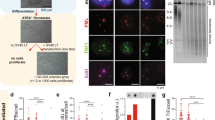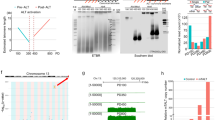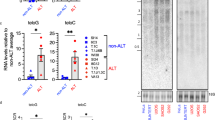Abstract
Most human somatic cells do not express telomerase. Consequently, with each cell division their telomeres progressively shorten until replicative senescence is induced. Around 15% of human cancers maintain their telomeres using telomerase-independent, recombination-based mechanisms that are collectively termed 'alternative lengthening of telomeres' (ALT). In the yeast Saccharomyces cerevisiae, ALT cells are referred to as 'survivors'. One type of survivor (type II) resembles human ALT cells in that both are defined by the amplification of telomeric repeats. We analyzed recombination-mediated telomere extension events at individual telomeres in telomerase-negative yeast during the formation of type II survivors and found that long telomeres were preferentially extended. Furthermore, senescent cells with long telomeres were more efficient at bypassing senescence by the type II pathway. We speculate that telomere length may be important in determining whether cancer cells use telomerase or ALT to bypass replicative senescence.
This is a preview of subscription content, access via your institution
Access options
Subscribe to this journal
Receive 12 print issues and online access
$189.00 per year
only $15.75 per issue
Buy this article
- Purchase on Springer Link
- Instant access to full article PDF
Prices may be subject to local taxes which are calculated during checkout





Similar content being viewed by others
References
de Lange, T. How telomeres solve the end-protection problem. Science 326, 948–952 (2009).
Kim, N.W. et al. Specific association of human telomerase activity with immortal cells and cancer. Science 266, 2011–2015 (1994).
Shay, J.W. & Bacchetti, S. A survey of telomerase activity in human cancer. Eur. J. Cancer 33, 787–791 (1997).
Greider, C.W. & Blackburn, E.H. Identification of a specific telomere terminal transferase activity in Tetrahymena extracts. Cell 43, 405–413 (1985).
Cesare, A.J. & Reddel, R.R. Alternative lengthening of telomeres: models, mechanisms and implications. Nat. Rev. Genet. 11, 319–330 (2010).
Lundblad, V. & Blackburn, E.H. An alternative pathway for yeast telomere maintenance rescues est1−–senescence. Cell 73, 347–360 (1993).
Le, S., Moore, J.K., Haber, J.E. & Greider, C.W. RAD50 and RAD51 define two pathways that collaborate to maintain telomeres in the absence of telomerase. Genetics 152, 143–152 (1999).
Teng, S.C. & Zakian, V.A. Telomere-telomere recombination is an efficient bypass pathway for telomere maintenance in Saccharomyces cerevisiae. Mol. Cell. Biol. 19, 8083–8093 (1999).
Chen, Q., Ijpma, A. & Greider, C.W. Two survivor pathways that allow growth in the absence of telomerase are generated by distinct telomere recombination events. Mol. Cell. Biol. 21, 1819–1827 (2001).
Lydeard, J.R., Jain, S., Yamaguchi, M. & Haber, J.E. Break-induced replication and telomerase-independent telomere maintenance require Pol32. Nature 448, 820–823 (2007).
Teng, S.C., Chang, J., McCowan, B. & Zakian, V.A. Telomerase-independent lengthening of yeast telomeres occurs by an abrupt Rad50p-dependent, Rif-inhibited recombinational process. Mol. Cell 6, 947–952 (2000).
Huang, P. et al. SGS1 is required for telomere elongation in the absence of telomerase. Curr. Biol. 11, 125–129 (2001).
Johnson, F.B. et al. The Saccharomyces cerevisiae WRN homolog Sgs1p participates in telomere maintenance in cells lacking telomerase. EMBO J. 20, 905–913 (2001).
Tsukamoto, Y., Taggart, A.K. & Zakian, V.A. The role of the Mre11-Rad50-Xrs2 complex in telomerase- mediated lengthening of Saccharomyces cerevisiae telomeres. Curr. Biol. 11, 1328–1335 (2001).
Straatman, K.R. & Louis, E.J. Localization of telomeres and telomere-associated proteins in telomerase-negative Saccharomyces cerevisiae. Chromosome Res. 15, 1033–1050 (2007).
Bryan, T.M., Englezou, A., Gupta, J., Bacchetti, S. & Reddel, R.R. Telomere elongation in immortal human cells without detectable telomerase activity. EMBO J. 14, 4240–4248 (1995).
Bryan, T.M., Englezou, A., Dalla-Pozza, L., Dunham, M.A. & Reddel, R.R. Evidence for an alternative mechanism for maintaining telomere length in human tumors and tumor-derived cell lines. Nat. Med. 3, 1271–1274 (1997).
McEachern, M.J. & Haber, J.E. Break-induced replication and recombinational telomere elongation in yeast. Annu. Rev. Biochem. 75, 111–135 (2006).
Henson, J.D. et al. DNA C-circles are specific and quantifiable markers of alternative-lengthening-of-telomeres activity. Nat. Biotechnol. 27, 1181–1185 (2009).
Larrivée, M. & Wellinger, R.J. Telomerase- and capping-independent yeast survivors with alternate telomere states. Nat. Cell Biol. 8, 741–747 (2006).
Teixeira, M.T., Arneric, M., Sperisen, P. & Lingner, J. Telomere length homeostasis is achieved via a switch between telomerase-extendible and -nonextendible states. Cell 117, 323–335 (2004).
Arnerić, M. & Lingner, J. Tel1 kinase and subtelomere-bound Tbf1 mediate preferential elongation of short telomeres by telomerase in yeast. EMBO Rep. 8, 1080–1085 (2007).
Lingner, J. et al. Reverse transcriptase motifs in the catalytic subunit of telomerase. Science 276, 561–567 (1997).
Förstemann, K., Hoss, M. & Lingner, J. Telomerase-dependent repeat divergence at the 3′ ends of yeast telomeres. Nucleic Acids Res. 28, 2690–2694 (2000).
Chang, M., Arneric, M. & Lingner, J. Telomerase repeat addition processivity is increased at critically short telomeres in a Tel1-dependent manner in Saccharomyces cerevisiae. Genes Dev. 21, 2485–2494 (2007).
Lee, J.Y., Kozak, M., Martin, J.D., Pennock, E. & Johnson, F.B. Evidence that a RecQ helicase slows senescence by resolving recombining telomeres. PLoS Biol. 5, e160 (2007).
Kozak, M.L. et al. Inactivation of the Sas2 histone acetyltransferase delays senescence driven by telomere dysfunction. EMBO J. 29, 158–170 (2010).
Hardy, C.F., Sussel, L. & Shore, D.A. RAP1-interacting protein involved in transcriptional silencing and telomere length regulation. Genes Dev. 6, 801–814 (1992).
Wotton, D. & Shore, D. A novel Rap1p-interacting factor, Rif2p, cooperates with Rif1p to regulate telomere length in Saccharomyces cerevisiae. Genes Dev. 11, 748–760 (1997).
Bonetti, D. et al. Shelterin-like proteins and Yku inhibit nucleolytic processing of Saccharomyces cerevisiae telomeres. PLoS Genet. 6, e1000966 (2010).
Hemann, M.T., Strong, M.A., Hao, L.Y. & Greider, C.W. The shortest telomere, not average telomere length, is critical for cell viability and chromosome stability. Cell 107, 67–77 (2001).
Khadaroo, B. et al. The DNA damage response at eroded telomeres and tethering to the nuclear pore complex. Nat. Cell Biol. 11, 980–987 (2009).
Abdallah, P. et al. A two-step model for senescence triggered by a single critically short telomere. Nat. Cell Biol. 11, 988–993 (2009).
Britt-Compton, B., Capper, R., Rowson, J. & Baird, D.M. Short telomeres are preferentially elongated by telomerase in human cells. FEBS Lett. 583, 3076–3080 (2009).
Singer, B.S., Gold, L., Gauss, P. & Doherty, D.H. Determination of the amount of homology required for recombination in bacteriophage T4. Cell 31, 25–33 (1982).
Watt, V.M., Ingles, C.J., Urdea, M.S. & Rutter, W.J. Homology requirements for recombination in Escherichia coli. Proc. Natl. Acad. Sci. USA 82, 4768–4772 (1985).
Shen, P. & Huang, H.V. Homologous recombination in Escherichia coli: dependence on substrate length and homology. Genetics 112, 441–457 (1986).
Jinks-Robertson, S., Michelitch, M. & Ramcharan, S. Substrate length requirements for efficient mitotic recombination in Saccharomyces cerevisiae. Mol. Cell. Biol. 13, 3937–3950 (1993).
Rubnitz, J. & Subramani, S. The minimum amount of homology required for homologous recombination in mammalian cells. Mol. Cell. Biol. 4, 2253–2258 (1984).
Liskay, R.M., Letsou, A. & Stachelek, J.L. Homology requirement for efficient gene conversion between duplicated chromosomal sequences in mammalian cells. Genetics 115, 161–167 (1987).
Pâques, F. & Haber, J.E. Multiple pathways of recombination induced by double-strand breaks in Saccharomyces cerevisiae. Microbiol. Mol. Biol. Rev. 63, 349–404 (1999).
Grandin, N. & Charbonneau, M. Telomerase- and Rad52-independent immortalization of budding yeast by an inherited-long-telomere pathway of telomeric repeat amplification. Mol. Cell. Biol. 29, 965–985 (2009).
Lebel, C. et al. Telomere maintenance and survival in Saccharomyces cerevisiae in the absence of telomerase and RAD52. Genetics 182, 671–684 (2009).
Levy, D.L. & Blackburn, E.H. Counting of Rif1p and Rif2p on Saccharomyces cerevisiae telomeres regulates telomere length. Mol. Cell. Biol. 24, 10857–10867 (2004).
Sherman, F. Getting started with yeast. Methods Enzymol. 194, 3–21 (1991).
Janeja, V.P. & Atluri, V. LS3: a linear semantic scan statistic technique for detecting anomalous windows. ACM Symp. Applied Computing 493–497 (2005).
Shi, L. & Janeja, V.P. Anomalous window discovery through scan statistics for linear intersecting paths (SSLIP). Proc. 15th ACM SIGKDD Int. Conf. Knowledge Discovery and Data Mining 767–775 (2009).
Dionne, I. & Wellinger, R.J. Cell cycle-regulated generation of single-stranded G-rich DNA in the absence of telomerase. Proc. Natl. Acad. Sci. USA 93, 13902–13907 (1996).
Acknowledgements
We thank K. Bernstein, B. Luke and P. Thorpe for comments on the manuscript. M.C. was supported by a Long-term Fellowship Award from the International Human Frontier Science Program (HFSP) organization and a Terry Fox Foundation Fellowship Award. This work was supported by funds from the US National Institutes of Health (CA009503 and GM008798 to J.C.D.; GM50237 to R.R.).
Author information
Authors and Affiliations
Contributions
M.C. designed and carried out the experiments, analyzed the data and wrote the manuscript. J.C.D. did the statistical analysis of the STEX data. R.R. helped to analyze the data and write the manuscript.
Corresponding author
Ethics declarations
Competing interests
The authors declare no competing financial interests.
Supplementary information
Supplementary Text and Figures
Supplementary Figure 1 and Supplementary Table 1 (PDF 529 kb)
Rights and permissions
About this article
Cite this article
Chang, M., Dittmar, J. & Rothstein, R. Long telomeres are preferentially extended during recombination-mediated telomere maintenance. Nat Struct Mol Biol 18, 451–456 (2011). https://doi.org/10.1038/nsmb.2034
Received:
Accepted:
Published:
Issue Date:
DOI: https://doi.org/10.1038/nsmb.2034
This article is cited by
-
A subtelomeric region affects telomerase-negative replicative senescence in Saccharomyces cerevisiae
Scientific Reports (2019)
-
Telomeric RNA-DNA hybrids affect telomere-length dynamics and senescence
Nature Structural & Molecular Biology (2013)



